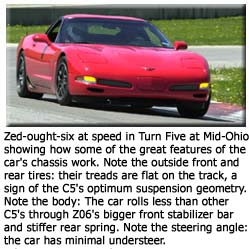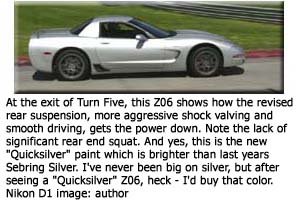|
Page-2
2001 Corvette Z06 by Hib Halverson
Cutting Edge Handling
While such an improvement obviously required hardware
changes to the C5 suspension; no way could the Zed-ought-six be as good
as it is without three characteristics at the core of any í97-up
Corvetteís good ride-and-handling.
1) Stiff structure: backbone construction with
enclosed driveline tunnel and hydroformed outer frame rails make the carís
structure one of the stiffest in the world. Hardtops are the stiffest of
all C5s because they have both the Coupeís "top bow" and the
Convertibleís extra crossbar behind the seats. Bodywork behind the
windshield and above the belt line is bolted to the windshield header
and is bolted and bonded to the rear deck. The underbody structure, the
fixed roof and the lack of the big hole in the back for the Coupeís
hatch make the Hardtop about 12% stiffer in torsion than a Coupe with
its roof in place. Rocket scientists out there will be interested to
know the convertibleís first torsional frequency is 20hz. Coupes with
the roof out are at 20.5hz and, with the roof on, jump to 22hz. The Z06
is a stout, 24hz.
2) Optimum suspension geometry: to enhance lateral
acceleration, all four wheels have static negative camber. Camber change
and roll stiffness are such that the car handles comfortably in everyday
driving but, when driven hard, generates substantial lateral grip. Both
the front and rear suspensions have virtually zero toe change though 95%
of their vertical travel. They also have virtually no toe change under
tractive, impact or lateral loads.
3) Ride decoupled from handling: "ride"
bushings, which isolate fore/aft movement of the control arms, are soft
to reduce impact harshness, but "handling" bushings,
which isolate lateral movement of the arms, are hard to minimize
unwanted toe or camber changes during high lateral acceleration.

These properties give the basic suspension enough
ride-quality bandwidth that Z06ís roll stiffness can be racheted-up
past that of the Z51 Sport Suspension without making the ride
unbearable. Itís easy to make a car go around corners like it was on
rails, but itís hard to do that and still have the car ride
comfortably and be pleasurable in the non-limit situations typical of
everyday street driving. Thankfully, Team Corvette was pretty successful
in doing that.
The new chassis tuning, known collectively as the
"FE4, Z06 High Performance Suspension" begins with added front
roll stiffness via a higher-rate, front stabilizer bar. Its diameter is
1.181 in., up .055 in. from the 2000-í01 Z51 bar.
In back, to add roll stiffness and reduce
acceleration squat, there is a new rear spring having a rate 10% higher
than Z51. The rear jounce bumpers are half an inch shorter which
increases rear suspension travel a bit. In a limit handling situation,
upon exiting a turn, if the suspension bottoms through the combination
of body roll and torque application, the spring rate goes through the
roof. The sudden increase in rate causes a corresponding, sudden and
undesirable oversteer. On the Z06, a small rear spring
rate increase and slightly more rear travel
means it can get power down better exiting turns without resorting
to a much larger spring rate increase and
the penalty in ride that would bring.

As with Z51, Sachs shocks are used. Shock valving for Z06 changed in
three areas compared to Z51. Damping of low
velocity suspension movement typical
of body roll was increased at all four corners. Mike Neal said adding
low velocity damping slows body roll, firms the ride a bit and improves
the front suspensionĻs response in transient maneuvers, such as quick
lane changes or autocross chicanes.
At the rear only, high velocity damping
was changed, with compression damping actually decreasing (because of
the higher spring rate) and rebound damping increasing, to improve wheel
control.
While they are noticeable changes by themselves, the
FE4 pieces donít fully account for such a huge, improvement in
handling. Goodyear, the only-remaining, big American tire company, is
behind much of the Zed-ought-sixís affinity for godawful fast driving
through a new, ultra-performance radial tire developed especially for
this car. Goodyearís partnership with Corvette dates to 1978 and this
marks the fifth time itís developed a tire especially for Americaís
Sports Car. Called the "Eagle F1 SC" (for "Supercar"),
this new tire had the Eagle F1 Fiorano, some aggressive rubber Goodyear
builds as an original equipment tire for Ferrari, as its development
starting point. |